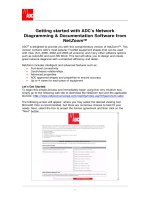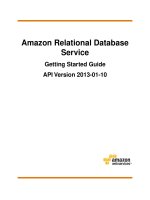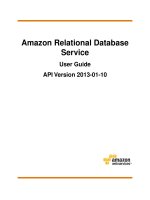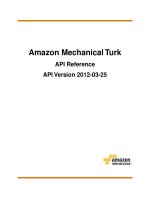Amazon Mechanical Turk Getting Started Guide API Version 2012-03-25 doc
Bạn đang xem bản rút gọn của tài liệu. Xem và tải ngay bản đầy đủ của tài liệu tại đây (210.19 KB, 37 trang )
Amazon Mechanical Turk
Getting Started Guide
API Version 2012-03-25
Amazon Web Services
Amazon Mechanical Turk Getting Started Guide
Amazon Mechanical Turk: Getting Started Guide
Amazon Web Services
Copyright © 2013 Amazon Web Services, Inc. and/or its affiliates. All rights reserved.
The following are trademarks of Amazon Web Services, Inc.: Amazon, Amazon Web Services Design, AWS,
Amazon CloudFront, Cloudfront, Amazon DevPay, DynamoDB, ElastiCache, Amazon EC2, Amazon Elastic
Compute Cloud, Amazon Glacier, Kindle, Kindle Fire, AWS Marketplace Design, Mechanical Turk, Amazon
Redshift, Amazon Route 53, Amazon S3, Amazon VPC. In addition, Amazon.com graphics, logos, page
headers, button icons, scripts, and service names are trademarks, or trade dress of Amazon in the U.S.
and/or other countries. Amazon's trademarks and trade dress may not be used in connection with any
product or service that is not Amazon's, in any manner that is likely to cause confusion among customers,
or in any manner that disparages or discredits Amazon.
All other trademarks not owned by Amazon are the property of their respective owners, who may or may
not be affiliated with, connected to, or sponsored by Amazon.
Amazon Mechanical Turk Getting Started Guide
Welcome 1
Introduction to Amazon Mechanical Turk 3
Setting Up Accounts and Tools 6
Creating a HIT 12
Implementing Amazon Mechanical Turk 28
Document History 33
API Version 2012-03-25
4
Amazon Mechanical Turk Getting Started Guide
Welcome
This is the Amazon Mechanical Turk Getting Started Guide.This guide provides a conceptual overview
of Amazon Mechanical Turk for developers who want to write scripts or software applications using the
Amazon Mechanical Turk SDKs.The major sections of this guide are described in the following table.
For information on using a graphical user interface to access Amazon Mechanical Turk functionality, go
to the Amazon Mechanical Turk Requester User Interface Guide.
Amazon Mechanical Turk is a web service that provides an on-demand, scalable, human workforce to
complete jobs that humans can do better than computers, such as recognizing objects in photographs.
For more information about this product, go to Amazon Mechanical Turk.
How Do I ?
Relevant TopicsHow do I ?
Introduction to Amazon Mechanical Turk (p. 3)Get a general product overview of
Mechanical Turk
Setting Up Accounts and Tools (p. 6)Set up the accounts and tools needed
to use Mechanical Turk
Creating a HIT (p. 12)Use the Mechanical Turk SDKs to write
and publish a Human Intelligence Task
(HIT)
Implementing Amazon Mechanical Turk (p. 28)Learn more about implementing
Mechanical Turk
Amazon Mechanical Turk Technical FAQFind answers to common questions
about Mechanical Turk
Amazon Mechanical Turk Developer GuideLearn more about programmatically
interacting with Mechanical Turk
Amazon Mechanical Turk API ReferenceFind detailed information about
Mechanical Turk operations
API Version 2012-03-25
1
Amazon Mechanical Turk Getting Started Guide
How Do I ?
Relevant TopicsHow do I ?
Amazon Mechanical Turk Release NotesFind information about the latest release
of Mechanical Turk
API Version 2012-03-25
2
Amazon Mechanical Turk Getting Started Guide
How Do I ?
Introduction to Amazon Mechanical
Turk
Topics
• Overview of Amazon Mechanical Turk (p. 3)
• Key Amazon Mechanical Turk Concepts (p. 4)
• Overview of Examples (p. 5)
This introduction to Amazon Mechanical Turk provides a high-level overview of this web service. After
reading this section, you should understand the basics you need to work through the examples in this
guide.
Overview of Amazon Mechanical Turk
Amazon Mechanical Turk provides an on-demand, scalable, human workforce to complete jobs that
humans can do better than computers. Amazon Mechanical Turk software formalizes job offers to the
thousands of Workers willing to do piecemeal work at their convenience.The software also retrieves work
performed and compiles it for you, the Requester, who pays the Workers for satisfactory work (only).
Optional qualification tests enable you to select competent Workers.
The kinds of tasks humans can complete better than computers includes finding objects in photos, writing
reviews of restaurants, movies, or businesses, translating text passages into foreign languages, getting
the hours of operation of the business center within a hotel, determining if a hotel is family-friendly, or
telling you the most relevant search results for a given phrase.
This guide presents a very slim slice of the Amazon Mechanical Turk API. For a complete description of
the entire API, go to the Amazon Mechanical Turk API Reference. For more information about using the
API, go to the Amazon Mechanical Turk Developer Guide.
Features
The following list describes the features of Amazon Mechanical Turk highlighted by the tutorial in this
guide.
• On-demand workforce—Amazon Mechanical Turk provides access to a virtual community of Workers.
API Version 2012-03-25
3
Amazon Mechanical Turk Getting Started Guide
Overview of Amazon Mechanical Turk
• Create jobs that Workers perform over the Internet—Advertise your job to the thousands of Amazon
Mechanical TurkWorkers around the world
You prescribe the job (HIT) that Workers complete using their computer, and pay them for their work.
• Test and publish your jobs—Test your applications in the Amazon Mechanical Turk sandbox
Test your jobs in the Amazon Mechanical Turk sandbox and publish the revised jobs to the outside
world.
Amazon Mechanical Turk provides SDKs and command line tools to make it easier to build solutions
leveraging Amazon Mechanical Turk.
Key Amazon Mechanical Turk Concepts
Topics
• Requester (p. 4)
• Human Intelligence Task (p. 4)
• Worker (p. 4)
• Assignment (p. 4)
• Reward (p. 5)
This section describes key Amazon Mechanical Turk concepts.
Requester
A Requester is a company, organization, or person that creates and submits tasks (HITs) to Amazon
Mechanical Turk for Workers to perform. As a Requester, you can use a software application to interact
with Amazon Mechanical Turk to submit tasks, retrieve results, and perform other automated tasks.You
can use the Requester website to check the status of your HITs, and manage your account.
Human Intelligence Task
A Human Intelligence Task (HIT) is a task that a Requester submits to Amazon Mechanical Turk for
Workers to perform. A HIT represents a single, self-contained task, for example, "Identify the car color in
the photo." Workers can find HITs listed on the Amazon Mechanical Turk website. For more information,
go to the Amazon Mechanical Turk website.
Each HIT has a lifetime, specified by the Requester, that determines how long the HIT is available to
Workers. A HIT also has an assignment duration, which is the amount of time a Worker has to complete
a HIT after accepting it.
Worker
A Worker is a person who performs the tasks specified by a Requester in a HIT.Workers use the Amazon
Mechanical Turk website to find and accept assignments, enter values into the question form, and submit
the results.The Requester specifies how many Workers can work on a task. Amazon Mechanical Turk
guarantees that a Worker can work on each task only one time.
Assignment
An assignment specifies how many people can submit completed work for your HIT. When a Worker
accepts a HIT, Amazon Mechanical Turk creates an assignment to track the work to completion. The
API Version 2012-03-25
4
Amazon Mechanical Turk Getting Started Guide
Key Amazon Mechanical Turk Concepts
assignment belongs exclusively to the Worker and guarantees that the Worker can submit results and
be eligible for a reward until the time the HIT or assignment expires.
Reward
A reward is the money you, as a Requester, pay Workers for satisfactory work they do on your HITs
Overview of Examples
This guide provides examples that show how to use the Amazon Mechanical Turk. It provides SDKs and
command line tools to create a survey and publish it as a HIT.
Showing Your Preferred Programming Language
If you are viewing the HTML version of this guide, you can hide the text in this section that does not pertain
to the programming language you are using. There is a Filter View: drop-down menu in the upper-right
corner of pages with language-specific text. Select a computer language to show the examples in only
that computer language, or select All to show the examples in all available computer languages.
You can also select Command Line Tools, which hides all code samples and leaves only information
related to the command line tools.
The next section explains how to sign up for AWS, Amazon Mechanical Turk, and set up your development
environment so that you can actually try the examples explained in the tutorial.You must complete all of
these tasks before you can use Amazon Mechanical Turk.
API Version 2012-03-25
5
Amazon Mechanical Turk Getting Started Guide
Reward
Setting Up Accounts and Tools
Topics
• Installing Your Programming Tools (p. 6)
• Creating an AWS Account (p. 8)
• Viewing Your AWS Security Credentials (p. 9)
• Setting Up Your Requester Account (p. 10)
• Prepay for Your HITs (p. 10)
This section describes the tasks you need to perform before you can use Amazon Mechanical Turk. If
you have already developed applications for another AWS product, you only need to sign up for Amazon
Mechanical Turk. For more information, see Setting Up Your Requester Account (p. 10). Otherwise,
complete all of the tasks in this section.
Installing Your Programming Tools
Amazon Mechanical Turk provides SDKs and command line tools designed to make it easier for you to
build solutions leveraging Amazon Mechanical Turk. These SDKs and tools hide the complexity and
simplify using the Amazon Mechanical Turk APIs.
The sections below provide instructions for installing the SDKs and command line tools.You must install
one of the SDKs or the command line tools to run the examples in this guide.
Showing Your Preferred Programming Language
If you are viewing the HTML version of this guide, you can hide text on this page that does not pertain to
the programming language you are using. There is a Filter View: drop-down menu in the upper-right
corner of pages with language-specific text. Select a computer language to show the examples in only
that computer language, or select All to show the examples in all available computer languages.
Installing Command Line Tools
You must install and configure the command line tools correctly before you can use the command line
to work through the examples in this guide.
If you use Unix, use the following procedure.
API Version 2012-03-25
6
Amazon Mechanical Turk Getting Started Guide
Installing Your Programming Tools
To install the Amazon Mechanical Turk command line tools for Unix users
1. Go to Amazon Mechanical Turk Command Line Tools.
2. Go to the [Command Line Tools Installation Directory]\ directory and open the file
Overview.html.
3. Follow the instructions in the section "Installing the command line tools" in the Overview.html file
to install and configure the command line tools.
You need your Access Key ID and Secret Access Key for this step.
If you use Windows, use the following procedure.
To install the Amazon Mechanical Turk command line tools for Windows Users
1. Go to Amazon Mechanical Turk Command Line Tools and download the command line tools.
2. Run mech-turk-setup.exe and follow the instructions.
This setup wizard installs and configures the command line tools.You need your Access Key ID and
Secret Access Key for this step.
Install C# Tools
To install and configure the Amazon Mechanical Turk SDK for .Net
1. Go to Amazon Mechanical Turk SDK for .NET and download the Amazon Mechanical Turk SDK for
.NET.
2. Open the file [SDK Installation Directory]\Overview.html.
3. Verify that you meet the prerequisites listed in the "Prerequisites" section of the Overview.html
file.
4. Follow the instructions in the section "Installing the Amazon Mechanical Turk SDK for .NET" of the
Overview.html file to install and configure the SDK.
You need your Access Key ID and Secret Access Key for this step.
You must configure the SDK correctly before you can use the examples in this guide.
Install Java Tools
To install the Amazon Mechanical Turk SDK for Java
1. Go to Amazon Mechanical Turk SDK for Java and download the SDK for Java.
2. Open the file [SDK Installation Directory]\Overview.html.
3. Verify that you meet the prerequisites listed in the "Prerequisites" section of the Overview.html
file.
4. Follow the instructions in the section "Installing the SDK" of the Overview.html file to install and
configure the SDK.
You need your Access Key ID and Secret Access Key for this step.
You must configure the SDK correctly before you can use the examples in this guide.
API Version 2012-03-25
7
Amazon Mechanical Turk Getting Started Guide
Install C# Tools
Install Perl Tools
To install the Amazon Mechanical Turk SDK for Perl
1. Go to Amazon Mechanical Turk SDK for Perl and download the SDK for Perl.
2. Open the file [SDK Installation Directory]\README.
3. Verify that you meet the prerequisites listed in the "Prerequisites" section of the README file.
4. Follow the instructions in the "Installation" section of the README file to install and configure the SDK.
You need your Access Key ID and Secret Access Key for this step.
You must configure the SDK correctly before you can use the examples in this guide.
Install Ruby Tools
To install the Ruby Libraries for Amazon Web Services
1. Go to Ruby Libraries for Amazon Web Services and download the Ruby libraries.
2. Open the file [SDK Installation Directory]\README.
3. Verify that you meet the prerequisites listed in the "Prerequisites" section of the README file.
4. Follow the instructions in the "Installation" section of the README file to install and configure the
libraries.
You need your Access Key ID and Secret Access Key for this step.
You must configure the SDK correctly before you can use the examples in this guide.
Creating an AWS Account
To develop with AWS web services, you must first create an AWS account. An AWS account is an
Amazon.com account that enables you to use AWS web services.You can use the login name and
password of your Amazon.com account to create your AWS account.
Important
If you have a personal Amazon.com account, you might want to have a separate Amazon.com
account reserved for your AWS activity.You could provide a new email address not already in
the Amazon.com system, or provide an email address for an existing Amazon.com account you
have but use a different password.You can have multiple Amazon.com accounts that use the
same email address, but different passwords.
From your AWS account, you can view your AWS account activity, view usage reports, and manage your
AWS account access identifiers. If you already have an AWS account, you can skip to the next section.
For more information, see Viewing Your AWS Identifiers (p. 9). If you have already know how to view
your AWS identifiers, you can skip right to signing up for Amazon Mechanical Turk. For more information,
see Setting Up Your Requester Account (p. 10). Otherwise, complete the tasks in this section.
To set up an AWS account
1. Go to .
2. In the Sign Up for AWS box, click Sign up today.
The Sign In page displays.
3. Enter a valid email address, select the button for No, I am a new customer, and click Continue.
API Version 2012-03-25
8
Amazon Mechanical Turk Getting Started Guide
Install Perl Tools
The next page asks for a password and a name that you want to associate with the account. If you
have an Amazon.com account, the email address for the account displays as the default login name.
4. Enter the name and password you want to associate with the account and click Continue.
The Account Info page displays.
5. Enter your contact information and select how you learned about AWS.Then read the AWS Customer
Agreement, select the check box to indicate that you've read and agree to the terms, and click
Continue.
The process is complete and you've created your AWS account.
Viewing Your AWS Security Credentials
AWS uses special identifiers to help protect your data. In this section, we show you how to view your
identifiers so you can use them. If you already know how to view your AWS security credentials, skip to
the next section.
AWS assigns you the following credentials when you create your AWS account:
• Access Key ID - A 20-character, alphanumeric sequence that you include in all AWS service requests
to identify yourself as the sender of the request.
• Secret Access Key - A 40-character sequence that you use to generate digital signatures.
Caution
Your Secret Access Key is a shared secret between you and AWS. Keep this ID secret; we use
it to bill you for the AWS services you use. Never include the ID in your requests to AWS and
never email the ID to anyone even if an inquiry appears to originate from AWS or Amazon.com.
No one who legitimately represents Amazon will ever ask you for your Secret Access Key.
When you create a request, you create a digital signature with your secret key and include it in the request
along with your Access Key ID. When we get the request, we use your Access Key ID to look up the
corresponding Secret Access Key. We use the key to validate the signature and confirm that you're the
request sender.
Important
You can use these access identifiers in both the sandbox and the production environment.
Your Access Key ID and Secret Access Key display when you create your AWS account. They are not
emailed to you. If you need to see them again, you can view them at any time from your AWS account.
To view your Access Key ID and Secret Access Key
1. Go to the Amazon Security Credentials page at If you
are not logged in, you will be prompted for your user name and password.
2. Your Access Key ID is displayed on the resulting Security Credentials page in the Access
Credentials area.Your Secret Access Key remains hidden as a further precaution as shown in the
following figure.
3. To display your Secret Access Key, on the Access Keys tab, under Secret Access Key, click Show.
API Version 2012-03-25
9
Amazon Mechanical Turk Getting Started Guide
Viewing Your AWS Security Credentials
Setting Up Your Requester Account
Before you can use Amazon Mechanical Turk, you must have an Amazon Mechanical Turk Requester
account.
To create and register a Requester account
1. Go to .
2. Click Create an Account.
3. Enter your email address.
Note
If you already have an Amazon.com account for your email address, you can sign in using
your email address and password.
4. Follow the prompts to complete your Requester account registration.
When prompted, you must enter your mailing address and you must accept the Amazon Mechanical
Turk Participation Agreement.
Prepay for Your HITs
This tutorial uses the Amazon Mechanical Turk sandbox in which you can execute Amazon Mechanical
Turk operations without having to pay Workers for working on your HITs. We recommend that you use
the sandbox to test your applications before moving them to the production system. Before you use the
production version of Amazon Mechanical Turk you need to prepay for the HITs you create. Otherwise,
you can't post your HITs to Workers.
To post your HITs to Workers, you must have money in your Prepaid HIT Balance to prepay for all of
your HITs.You can provide banking information, credit card or debit card information, or an Amazon
Payments account to prepay for the HITs.
If you use a bank account, it can take up to one week for your transfer to be approved. During that time
you can test your HITs in the Amazon Mechanical Turk Developer Sandbox, but you cannot create HITs
on the Amazon Mechanical Turk production system. If you use a credit card, debit card, or Amazon
Payments account to prepay, you can use the Amazon Mechanical Turk production system immediately.
For instructions on how to prepay for your HITs, go to the Requester website.
The next section is a tutorial that takes you step-by-step through using Amazon Mechanical Turk to create
a HIT. The tutorial is written procedurally so you should follow it from beginning to end. After completing
API Version 2012-03-25
10
Amazon Mechanical Turk Getting Started Guide
Setting Up Your Requester Account
the tutorial, you should have a good feel for the major tasks you can complete using Amazon Mechanical
Turk.
Alternately, you can skip the tutorial and jump right to the last section that provides links to code samples,
application examples, forums, and other resources designed to help you learn Amazon Mechanical Turk.
For more information, see Implementing Amazon Mechanical Turk (p. 28).
API Version 2012-03-25
11
Amazon Mechanical Turk Getting Started Guide
Prepay for Your HITs
Creating a HIT
Topics
• Workflow (p. 12)
• Working with the Examples (p. 13)
• What's Next? (p. 27)
In the previous section you set up your AWS account, viewed your AWS identifiers, and installed the tools
you need to use Amazon Mechanical Turk. In this section, you learn to write, publish, and manage a HIT.
This section also contains code examples that demonstrate how to create, test, and publish your HIT.
Workflow
The following procedure gives you an overview of creating, testing, publishing, and managing a HIT.
Workflow for Requesters
Write your HIT.
Write the question or task for Workers to answer or perform.
1
Test your HIT.
Publish your HIT on the Amazon Mechanical Turk Developer Sandbox. The Amazon Mechanical
Turk Developer Sandbox is a simulated environment that allows you to view your HIT as it would
appear to Workers.
For more information about the Amazon Mechanical Turk Developer Sandbox and how to use it,
go to the Amazon Mechanical Turk Developer Sandbox.
2
Publish your HIT on the Amazon Mechanical Turk production system.
This step makes your HIT available to Workers.
3
Workers accept your HIT and complete the assignment.
You can view the status of your HITs. For more information, go to the Requester website.
4
Process the assignment results.
When a Worker completes an assignment, you can view the results, output the results to a file, and
accept or reject the work. Accepting the work means that you agree to pay the Worker.
5
API Version 2012-03-25
12
Amazon Mechanical Turk Getting Started Guide
Workflow
Manage your HIT.
You can extend the completion time for your HIT, expire the HIT early, add additional assignments,
modify the HIT properties, or block Workers whose work does not meet your standards.
6
The examples in this section provide instructions for performing tasks 1, 2, and 3. For information about
tasks 5 and 6, see Implementing Amazon Mechanical Turk (p. 28).
Working with the Examples
The following examples use SDK operations or the command line tools to show you how to create a
survey that asks the question "How many movies have you seen this month?" The samples create a HIT
and print the HIT ID to the console. These examples demonstrate how to publish the HIT to the Amazon
Mechanical Turk Developer Sandbox for testing and then how to publish the HIT on the Amazon Mechanical
Turk production system.
The following sections show you how to create and publish a HIT using the command line interface or
the API and a programming language:
• Creating a HIT Using the Command Line Interface (p. 13)
• API and C# (p. 16)
• API and Java (p. 18)
• API and Perl (p. 21)
• API and Ruby (p. 24)
Showing Your Preferred Programming Language
If you are viewing the HTML version of this guide, you can hide the text in this section that does not pertain
to the programming language you are using. There is a Filter View: drop-down menu in the upper-right
corner of pages with language-specific text. Select a computer language to show the examples in only
that computer language, or select All to show the examples in all available computer languages.
You can also select Command Line Tools, which hides all code samples and leaves only information
related to the command line tools.
Creating a HIT Using the Command Line Interface
Topics
• How to Create a HIT (p. 13)
• How to Test Your HIT (p. 15)
• How to Publish Your HIT (p. 15)
This example uses the commands in the Amazon Mechanical Turk command line tools to create a survey.
You must have the command line tools installed and configured correctly to run this example.
How to Create a HIT
The following procedure describes how to create the HIT, "MovieSurvey."
API Version 2012-03-25
13
Amazon Mechanical Turk Getting Started Guide
Working with the Examples
To create the HIT
1. Create an input file, moviesurvey.input, a tab-delimited text file, and populate it with the variable
data for the HIT.
question
How many movies have you seen this month?
2. Create a question template file, moviesurvey.question, and add the text of your HIT template.
This XML file contains placeholders for the fields defined in the input file and conforms to the
QuestionForm schema.
<?xml version="1.0" encoding="UTF-8"?>
<QuestionForm xmlns="
DataSchemas/2005-10-01/QuestionForm.xsd">
<Question>
<QuestionIdentifier>1</QuestionIdentifier>
<QuestionContent>
<Text>${question}</Text>
</QuestionContent>
<AnswerSpecification>
<FreeTextAnswer/>
</AnswerSpecification>
</Question>
</QuestionForm>
3. Create a HIT properties file, moviesurvey.properties, and populate it with the properties of the
HIT (title, description, etc.)
######################################
## HIT Properties
######################################
title:Movie Survey
description:This is a survey to find out how many movies you have watched
recently.
keywords:movie, survey
reward:0.05
assignments:100
annotation:sample#command
######################################
## HIT Timing Properties
######################################
# this Assignment Duration value is 60 * 60 = 1 hour
assignmentduration:3600
# this HIT Lifetime value is 60*60*24*3 = 3 days
hitlifetime:259200
API Version 2012-03-25
14
Amazon Mechanical Turk Getting Started Guide
Creating a HIT Using the Command Line Interface
# this Auto Approval period is 60*60*24*15 = 15 days
autoapprovaldelay:1296000
4. Navigate to the [Command Line Tools Installation Directory]\bin directory to run the
commands.
How to Test Your HIT
To test your HIT, publish it in the sandbox by including the -sandbox argument with the loadHITs
command.
To test your HIT
1. Open a command prompt, navigate to the [Command Line Tools Installation
Directory]\bin directory, and run the following command:
loadHITs -input c:\moviesurvey\moviesurvey.input -question c:\moviesur
vey\moviesurvey.question -properties c:\moviesurvey\moviesurvey.properties
-sandbox
2. Go to the Amazon Mechanical Turk Developer Sandbox and view your HIT.
You can rewrite and rerun your HIT as often as you like.
How to Publish Your HIT
When you are satisfied with your HIT, publish it to the production system.
To publish your HIT to the production system
• Open a command prompt, navigate to the [Command Line Tools Installation
Directory]\bin directory and run the following command:
loadHITs -input c:\moviesurvey\moviesurvey.input -question c:\moviesur
vey\moviesurvey.question -properties c:\moviesurvey\moviesurvey.properties
Your HIT is now on the production site.
Creating a HIT Using the API
Topics
• C# (p. 16)
• Java (p. 18)
• Perl (p. 21)
• Ruby (p. 24)
API Version 2012-03-25
15
Amazon Mechanical Turk Getting Started Guide
Creating a HIT Using the API
The following sections explain how to create a HIT using the Amazon Mechanical Turk API.
C#
The following example uses the methods of the Amazon Mechanical Turk SDK for .Net to create the
movie survey.You must have the SDK installed and configured correctly to run this example.To download
the SDK go to Amazon Mechanical Turk SDK for .NET.
How to Create a HIT
This section shows how to create a HIT.
To create the HIT
1. Add a project reference to [SDK Installation
Directory]\lib\Amazon.WebServices.MechanicalTurk.dll.
2. Add the following using statements to your source code:
• using Amazon.WebServices.MechanicalTurk
• using Amazon.WebServices.MechanicalTurk.Domain
3. Copy the app.config file from the [SDK Installation Directory]\src directory to your
project directory and add the file to your project. This file contains the configuration and the AWS
identifier information for your application.
4. Create a SimpleClient object. This class provides a client used to invoke single operations for
Mechanical Turk. Typically, you create this object once and use it throughout your application.
static SimpleClient client = new SimpleClient();
5. Use one of the CreateHIT() methods in the SimpleClient class to create a HIT. The following
example uses the CreateHIT() method that requires values for the title, description, reward,
question, and maxAssignments parameters of the method.
HIT hit = client.CreateHIT(
"Movie Survey",
"This is a survey to find out how many movies you have watched recently.",
new decimal(0.05), "How many movies have you seen this month?", 100);
The following example pulls together all the code described in the preceding procedure.
using System;
using System.Collections.Generic;
using System.Text;
using Amazon.WebServices.MechanicalTurk;
using Amazon.WebServices.MechanicalTurk.Domain;
namespace CreateHITExample
API Version 2012-03-25
16
Amazon Mechanical Turk Getting Started Guide
Creating a HIT Using the API
{
class Program
{
// Create a client as a class member.
static SimpleClient client = new SimpleClient();
static void Main(string[] args)
{
CreateNewHIT();
}
static void CreateNewHIT()
{
// Create a HIT with the specified parameters.
HIT hit = client.CreateHIT(
"Movie Survey",
// title
"This is a survey to find out how many movies you have watched
recently.", // description
new decimal(0.05),
// reward
"How many movies have you seen this month?",
// question
100);
// number of assignments
// Write the new HIT Id to the console.
Console.WriteLine("Created HIT: {0}", hit.HITId);
Console.WriteLine("Hit Location: {0}", client.GetPreviewURL(hit.HIT
TypeId));
}
}
}
How to Test Your HIT
When you compile and run the code example, your HIT is published on the Amazon Mechanical Turk
Developer Sandbox by default. This is a simulated environment that enables you to view your HIT as it
would appear to Workers. The sandbox is a free test environment for all Requesters.
To test your HIT
1. Compile and run your project.
If no errors occur, you see output similar to the following:
Created HIT: 2X6T66XZQARRM98X5030
HIT Location:
RM98X5030
2. Go to the Amazon Mechanical Turk Developer Sandbox and view your HIT.You can rewrite and
recompile your HIT as often as necessary.
API Version 2012-03-25
17
Amazon Mechanical Turk Getting Started Guide
Creating a HIT Using the API
How to Publish Your HIT
When you are satisfied with your HIT, publish it on the Amazon Mechanical Turk production system. This
makes your HIT available for Workers to complete.
To publish your HIT
1. Open the App.config file for your project.
2. Under element <appSettings>, find the following entry:
<add key="MechanicalTurk.ServiceEndpoint" value="d
box.amazonaws.com?Service=AWSMechanicalTurkRequester"/>
3. Replace the entry with the following string:
<add key="MechanicalTurk.ServiceEndpoint" value="zon
aws.com/?Service=AWSMechanicalTurkRequester"/>
4. Save and close the file.
5. Run your application.
Your HIT is now on the production site.
Java
The following example uses the APIs of the Amazon Mechanical Turk SDK for Java to create the movie
survey.You must have the SDK installed and configured correctly before you run this example. To
download the SDK go to Amazon Mechanical Turk SDK for Java.
How to Create a HIT
This section shows how to create a HIT.
To create the HIT
1. Specify all the *.jar files in the [SDK Installation Directory]\lib directory and in the [SDK
Installation Directory]\lib\third-party directory in your classpath.
2. Specify all the *.jar files in the [SDK Installation Directory]\build\lib directory in your
classpath.
3. Copy the mturk.properties file to your project.This file contains the configuration information
needed for your project.
4. Import the following classes to your application.
• com.amazonaws.mturk.service.axis.RequesterService
• com.amazonaws.mturk.service.exception.ServiceException
• com.amazonaws.mturk.util.ClientConfig
• com.amazonaws.mturk.requester.HIT
5. Create a RequesterService object.This class provides the configuration information for your
application.
API Version 2012-03-25
18
Amazon Mechanical Turk Getting Started Guide
Creating a HIT Using the API
service = new RequesterService(new PropertiesClientConfig());
6. Use one of the CreateHIT() methods in the RequesterService class to create a HIT. The
following example uses the CreateHIT() method with parameter values for the title,
description, reward, and maxAssignments properties of the HIT.
HIT hit = service.createHIT
(
title,
description,
reward,
RequesterService.getBasicFreeTextQuestion(
"How many movies have you seen this month?"),
numAssignments);
The following example pulls together all the code described in the preceding procedure.
package createnewhit;
import com.amazonaws.mturk.service.axis.RequesterService;
import com.amazonaws.mturk.service.exception.ServiceException;
import com.amazonaws.mturk.util.PropertiesClientConfig;
import com.amazonaws.mturk.requester.HIT;
/**
* The MovieSurvey sample application creates a simple HIT using the
* Amazon Mechanical Turk SDK for Java. The file mturk.properties must be found
in the current file path.
*/
public class MovieSurvey{
private RequesterService service;
// Define the properties of the HIT to be created.
private String title = "Movie Survey";
private String description =
"This is a survey to find out how many movies you have watched recently.";
private int numAssignments = 100;
private double reward = 0.05;
/**
* Constructor
*/
public MovieSurvey()
{
service = new RequesterService(new PropertiesClientConfig());
}
/**
* Create a simple survey.
*
*/
public void createMovieSurvey()
API Version 2012-03-25
19
Amazon Mechanical Turk Getting Started Guide
Creating a HIT Using the API
{
try
{
// The createHIT method is called using a convenience static method
// RequesterService.getBasicFreeTextQuestion() that generates the question
format
// for the HIT.
HIT hit = service.createHIT
(
title,
description,
reward,
RequesterService.getBasicFreeTextQuestion(
"How many movies have you seen this month?"),
numAssignments);
// Print out the HITId and the URL to view the HIT.
System.out.println("Created HIT: " + hit.getHITId());
System.out.println("HIT location: ");
System.out.println(service.getWebsiteURL() + "/mturk/preview?groupId="
+ hit.getHITTypeId());
}
catch (ServiceException e)
{
System.err.println(e.getLocalizedMessage());
}
}
/**
* Main method
*
* @param args
*/
public static void main(String[] args)
{
// Create an instance of this class.
MovieSurvey app = new MovieSurvey();
// Create the new HIT.
app.createMovieSurvey();
}
}
How to Test Your HIT
This section shows how to test your HIT.
When you compile and run the code example, your HIT is published on the Amazon Mechanical Turk
Developer Sandbox.This is a simulated environment that enables you to view your HIT as it would appear
to Workers.The sandbox is a free test environment for all Requesters.
To test your HIT
1. Compile and run your project.
If no errors occur, you see output similar to the following:
API Version 2012-03-25
20
Amazon Mechanical Turk Getting Started Guide
Creating a HIT Using the API
Created HIT: 2X6T66XZQARRM98X5030
HIT Location:
/>2. Go to the Amazon Mechanical Turk Developer Sandbox and view your HIT.You can rewrite and
recompile your HIT as often as necessary.
How to Publish Your HIT
When you are satisfied with your HIT, publish it on the Amazon Mechanical Turk production system. This
makes your HIT available for Workers to complete.
To publish your HIT
1. Open the mturk.properties file for your project.
2. Comment out the Developer Sandbox service_url with a "#".
#service_url=
anicalTurkRequester
3. Remove the comment mark # from the Production site service_url.
service_url=
quester
4. Save and close the file.
5. Compile and run your application.
Your HIT is now on the production site.
Perl
This example creates a movie survey using the methods of the Amazon Mechanical Turk SDK for Perl.
You must have the SDK installed and configured correctly before you can run this example.To download
the SDK go to Amazon Mechanical Turk SDK for Perl.
How to Create a HIT
You can use several different methods to create a HIT.You can define the format for the question and
answer in a file.The following example writes the question format and the question in the script file. The
example prints out the ID and the location of the new HIT to the console.
To create the HIT
1. Add the following line to your module to use the MechanicalTurk class.
use NET::Amazon::MechanicalTurk;
2. Define the question format. In this example, this is a string that defines the XML format of the question.
API Version 2012-03-25
21
Amazon Mechanical Turk Getting Started Guide
Creating a HIT Using the API









